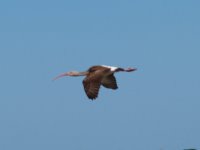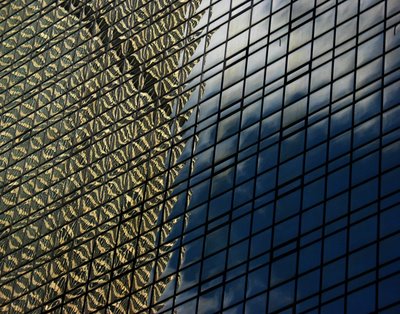 This is a picture I took in New York City; it's the reflection of a skyscraper, clouds, and the sky on another skyscraper. I took a close-up shot, avoiding the outline of the skyscrapers, to give it an abstract feel.
This is a picture I took in New York City; it's the reflection of a skyscraper, clouds, and the sky on another skyscraper. I took a close-up shot, avoiding the outline of the skyscrapers, to give it an abstract feel. Thursday, September 28, 2006
Reflection
 This is a picture I took in New York City; it's the reflection of a skyscraper, clouds, and the sky on another skyscraper. I took a close-up shot, avoiding the outline of the skyscrapers, to give it an abstract feel.
This is a picture I took in New York City; it's the reflection of a skyscraper, clouds, and the sky on another skyscraper. I took a close-up shot, avoiding the outline of the skyscrapers, to give it an abstract feel. Monday, September 25, 2006
Lighthouse
 I took this picture during a very cold night in December of 2001, in Michigan. I think I've never been so cold in my life (
I took this picture during a very cold night in December of 2001, in Michigan. I think I've never been so cold in my life ( you can see how the water sprayed by the waves on the handrail has frozen - more noriceable in the second picture - almost unbelievable...).
you can see how the water sprayed by the waves on the handrail has frozen - more noriceable in the second picture - almost unbelievable...).Sunday, September 24, 2006
Windows
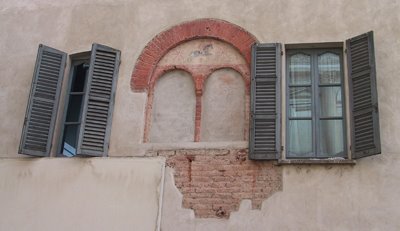 These windows are on the building opposite the Certosa; in one of them you can see the reflection of the windows of the Ducal Palace.
These windows are on the building opposite the Certosa; in one of them you can see the reflection of the windows of the Ducal Palace.It's interesting to see the traces of the long history of the building (probably built around the 15th century - I'm not sure because it's not one of the buildings of the Certosa that guidebooks mention), how the new windows have "grown" close to the old ones, like young trees growing next to an old stump.
Thursday, September 21, 2006
Nürnberg
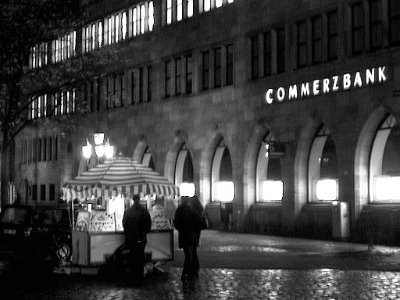
Sunday, September 17, 2006
Death Valley National Park
Death Valley is about 3 hours from Las Vegas, north on route 95, then south on 373 and west on 190.
 The first point of interest after entering the park is Dante's View, which offers a beautiful panoramic view over the southern part of the valley and the salt lake.
The first point of interest after entering the park is Dante's View, which offers a beautiful panoramic view over the southern part of the valley and the salt lake. Further along is Zabriskie Point, home to very interesting rock formation - actually, the whole valley is home to very interesting rock formations: besides the rock formations, the sand and the salt there is very little. Each corner of the valley is different though, I would never have thought that "rock formations" could be so very different before I went to the Southwest.
Further along is Zabriskie Point, home to very interesting rock formation - actually, the whole valley is home to very interesting rock formations: besides the rock formations, the sand and the salt there is very little. Each corner of the valley is different though, I would never have thought that "rock formations" could be so very different before I went to the Southwest.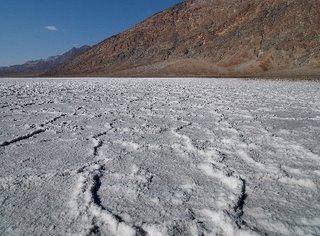 Shortly after Zabriskie Point you'll reach route 178; turn left and follow the road until Badwater; this is one of the spots from which you can access the salt lake without too much effort. Especially in the spring and summer months, Death Valley is extremely hot, and even short hikes can be dangerous, so don't underestimate even the shortest walk. People actually die in Death Valley fairly often.It's easy to underestimate the heat after you've been driving around for hours in a comfortably air-conditioned vehicle.
Shortly after Zabriskie Point you'll reach route 178; turn left and follow the road until Badwater; this is one of the spots from which you can access the salt lake without too much effort. Especially in the spring and summer months, Death Valley is extremely hot, and even short hikes can be dangerous, so don't underestimate even the shortest walk. People actually die in Death Valley fairly often.It's easy to underestimate the heat after you've been driving around for hours in a comfortably air-conditioned vehicle. Walking on the salt lake is like walking on April snow: the color and texture of the salt feel like snow, and in certain places your foot may break the surface and sink in a puddle of water. The water is coming from an underground system that, amazingly, even after thousands of years of desertification of the area, is still providing water. The salt lake is the lowest point in the continental US, if I recall correctly, some 282 feet (86 meters) below sea level. A sign halfway up the mountain marks sea level. Very impressive. It makes you want to imagine what it would look like here if there was water up to that level.
Walking on the salt lake is like walking on April snow: the color and texture of the salt feel like snow, and in certain places your foot may break the surface and sink in a puddle of water. The water is coming from an underground system that, amazingly, even after thousands of years of desertification of the area, is still providing water. The salt lake is the lowest point in the continental US, if I recall correctly, some 282 feet (86 meters) below sea level. A sign halfway up the mountain marks sea level. Very impressive. It makes you want to imagine what it would look like here if there was water up to that level. Back north on 178, there are at least 3 turnoffs worth mentioning.

The first is the Devil's Golf Course. It has been thus named because, if it were a golf course, it would be the most difficult one in the world. I don't doubt that, but it also would be the most difficult basketball court, or baseball field, or soccer field... I don't know why they went for the golf course. Anyway, it's an apparently interminable field of dirt and salt lumps. Very strange. In retrospect, I think it would be a good subject for a view camera, with the front tilted down and the back tilted backwards, to increase the proportions of the lumps. Unfortunately I didn't have my view camera yet. Maybe next time - the place is certainly worth a second visit.
 The next turnoff is Artist's Drive; it is so named because of the pictoresque colors of the rocks and mountains; the highlight of the drive is the Painter's Palette, a group of orange, red, green, blue and white rocks. However, even more than the colored rocks, I found interesting the small colorful flowers and bushes that somehow manage to grow in this inhospitable environment. Purple, green, yellow, white, they are a sight in themselves.
The next turnoff is Artist's Drive; it is so named because of the pictoresque colors of the rocks and mountains; the highlight of the drive is the Painter's Palette, a group of orange, red, green, blue and white rocks. However, even more than the colored rocks, I found interesting the small colorful flowers and bushes that somehow manage to grow in this inhospitable environment. Purple, green, yellow, white, they are a sight in themselves. The third turnoff is salt creek; how much of the creek you'll be able to see depends on the time of year, but it's a very amazing view: in the middle of the desert, rocks, sand and salt, there is a small creek surrounded by lush (relatively speaking) vegetation. Many millenia ago, the creek used to be full of fresh water; now the water is salty, and one species of fresh water fish, having little choice, adapted to the salt in the water. This species (Cyprinodon Salinus, or pupfish) exists only in this creek. You should be able to see quite a few of the little fishes. The Park has built a wooden boardwalk along the creek, so that the delicate environment is not spoiled by the tourists.
The third turnoff is salt creek; how much of the creek you'll be able to see depends on the time of year, but it's a very amazing view: in the middle of the desert, rocks, sand and salt, there is a small creek surrounded by lush (relatively speaking) vegetation. Many millenia ago, the creek used to be full of fresh water; now the water is salty, and one species of fresh water fish, having little choice, adapted to the salt in the water. This species (Cyprinodon Salinus, or pupfish) exists only in this creek. You should be able to see quite a few of the little fishes. The Park has built a wooden boardwalk along the creek, so that the delicate environment is not spoiled by the tourists. Back on route 190 in direction west, just before Stovepipe Wells, you'll see on the right the famous Death Valley dunes. You can park the car on the side of the road and walk to the dunes. The best time to do this is just before sundown: the heat is not as bad and the light is fantastic on the dunes. It took me about 2 hours to get to the tallest dune, walk around taking pictures, and come back to the road. If you attempt the hike, don't forget to bring lots of water: I brought about a gallon, drank all of it, and at the end I was dangerously close to dehydration. At dinner I drank a glass of water after the other, but I think the pictures were worth it.
Back on route 190 in direction west, just before Stovepipe Wells, you'll see on the right the famous Death Valley dunes. You can park the car on the side of the road and walk to the dunes. The best time to do this is just before sundown: the heat is not as bad and the light is fantastic on the dunes. It took me about 2 hours to get to the tallest dune, walk around taking pictures, and come back to the road. If you attempt the hike, don't forget to bring lots of water: I brought about a gallon, drank all of it, and at the end I was dangerously close to dehydration. At dinner I drank a glass of water after the other, but I think the pictures were worth it. We stayed at a motel in Stovepipe Wells; very nice place, with a view over the desert (see picture on the left), a cool saloon where you can enjoy a cold beer, and even a small swimming pool. At night I played with some long-exposure pictures. As you can see from the star trails, the exposure was a couple of minutes long.
We stayed at a motel in Stovepipe Wells; very nice place, with a view over the desert (see picture on the left), a cool saloon where you can enjoy a cold beer, and even a small swimming pool. At night I played with some long-exposure pictures. As you can see from the star trails, the exposure was a couple of minutes long.At the north end of the valley the main points of interest are Scotty's Castle and the Racetrack. The latter is well worth a photographic visit, but unfortunately our SUV had defective shocks and we weren't able to make it all the way to the end of the 30 mile long dirt road. If you attempt to get there, make sure that you have a good 4WD vehicle and plenty of time - the going is very slow.
 We didn't find Scotty's Castle particularly interesting, so we didn't take the guided tour, and instead headed back towards Beatty; we wanted to see the ghost town Rhyolite; it used to be a prosperous mining town at the turn of the last century, with even its own casino, but now it's just an agglomerate of empty shells of buildings.
We didn't find Scotty's Castle particularly interesting, so we didn't take the guided tour, and instead headed back towards Beatty; we wanted to see the ghost town Rhyolite; it used to be a prosperous mining town at the turn of the last century, with even its own casino, but now it's just an agglomerate of empty shells of buildings.From Beatty it's about another 2 hours to get back to Las Vegas.
The park is actually rather large; we didn't make it to the western part, and we skipped all of the canyon hikes. These may be more interesting than the things I wrote about, so make sure to find out about the other points of interest before you go.
Thursday, September 14, 2006
Resolution comparison: 4x5 view camera vs. 5MP dSLR

I feel kind of bad because I like my E-1 a lot, and obviously it's not fair to compare a 5MP digital image with a 105MP scan, but it was fun and interesting to do.
See the comparison here.
Sunday, September 10, 2006
The Photo-Travel Map
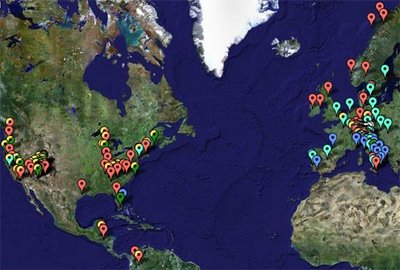
It's a satellite image of the Earth, where I superimposed markers that show (most of) the place that I have visited. When you click on a marker, a baloon pops up, with the description of the site and, in some cases, a small picture.
The map is a regular Google map, so you can navigate, zoom in and out, and explore.
At this time there are almost 200 markers, so it will take a few seconds to load (if you have high-speed internet - otherwise longer); please be patient. I will add more markers and pictures as I travel to new places.
If you want to make your own photo-travel-map, look at this tutorial.
Friday, September 08, 2006
Wright Brothers National Memorial
This is where Wilbur and Orville Wright attempted to fly for about 3 years, until they finally succeded in December of 1903.

There isn't much to see there: some markers that show where the plane started, took off, and landed again; a re-enactment (with mannequins) of the moment of flight (see picture above); and a nice futuristic monument to flight (see picture below - I tried to add a futuristic painting touch to it because the regular picture looked too much like a postcard).

There is also a small museum in the visitor center; it's pretty interesting, with a lot of information on flight and the work of the Wright brothers. Their story is fascinating, so don't miss out on it.
Cape Hatteras National Seashore (NC Outer Banks)
First in line is the trip to the Outer Banks in North Carolina, in March of this year. The Outer Banks are a string of very narrow islands out in the Atlantic Ocean, several miles away from the North carolina coast.
It was still rather cold, so there were very few people around. Good.
 The highlight of Cape Hatteras National Seashore is obviously the Cape Hatteras lighthouse. Unfortunately, a few years ago it was moved inland because the coast's erosion was threatening it, so it has become a much less interesting photographic subject. A lighthouse in the middle of a field surrounded by woods is not exactly spectacular. You do hear the ocean in the distance, though.
The highlight of Cape Hatteras National Seashore is obviously the Cape Hatteras lighthouse. Unfortunately, a few years ago it was moved inland because the coast's erosion was threatening it, so it has become a much less interesting photographic subject. A lighthouse in the middle of a field surrounded by woods is not exactly spectacular. You do hear the ocean in the distance, though.Fortunately the local fauna can help give a little more interest to the pictures:

 Not far north of Cape Hatteras, there is another interesting lighthouse, on Bodie Island. There are actually several lighthouses in the area: North Carolina was one of the first states to be colonized, and in the 17th and 18th centuries many routes went by this part of the coast. Most of the lighthouses on these isalnds are well worth a visit.
Not far north of Cape Hatteras, there is another interesting lighthouse, on Bodie Island. There are actually several lighthouses in the area: North Carolina was one of the first states to be colonized, and in the 17th and 18th centuries many routes went by this part of the coast. Most of the lighthouses on these isalnds are well worth a visit.
You may have heard about the "lost colony", the first English colony in America, which was settled in 1587 by 120 people who then vanished without a trace within 3 years. To this day nobody knows exactly what happened to them. The lost colony was situated on Roanoke Island, just a couple of miles north of Bodie Island Lighthouse.
The area is also an important stop in the migratory path of many birds, so with a little patience you can spot some interesting birds. The best place to find migratory birds are two lakes in Pea Island National Wildlife Refuge, which is technically not part of Cape Hatteras NS, even though it lies in the middle of it.
I had just bought the ZD 40-150 and I was hoping to come home with some spectacular bird pictures, but it's actually a lot harder than it seems.
A couple of hard-learned lessons:
- Set the exposure manually, or at least use manual compensation to significantly increase the exposure: unless the bird is pretty much filling the frame, the camera is going to expose for a nice full blue sky. Unfortunately, this means that the bird is going to look like a black spot with no detail whatsoever.
- Use continuous autofocus, follow the bird in the viewfinder (harder than it seems) and keep shooting.
- Take lots and lots of pictures, in the hope that one of them will turn out ok. This is not a situation where you can visualize a picture, take it, and know that you have it. Don't try to finess it. Go for brute force.
- Use a relatively high ISO speed to keep the shutter very fast. Enough shots will end up out of focus anyway, you don't want the others to be motion-blurred.
- Use the longest and brightest lens you can afford. The birds are not going to come there for you.
Unfortunately I learnt these lessons after I came back and looked at the pictures. This is pretty much the best I have (the first is a White Ibis, the second a Blue Heron):
Monday, September 04, 2006
The Bender 4x5 View Camera Project is finished!
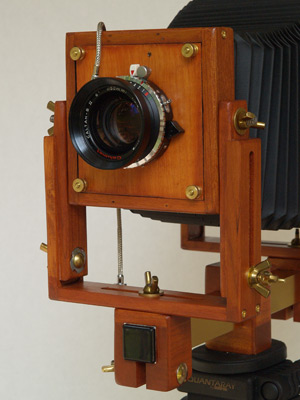
After a few months of inactivity, I'm back.
I completed the construction of the Bender 4x5 view camera (see picture on the right); you can find a full report about it here, some additional pictures here, and a comparison between 4x5 film and a dSLR here.
In the next few days I'll start updating this blog - there are lots of trips and photographs to talk about!
